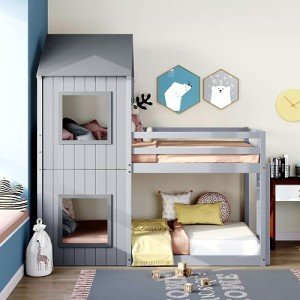Exploring Bunk Beds: A Comprehensive Guide
Bunk beds have long been a staple in children's bedrooms, dorm rooms, and even homes with restricted space. Not only do they offer a useful sleeping option, however they likewise produce an enjoyable and creative environment for children and a great space-saver for adults and households. This short article will explore everything you need to learn about bunk beds, from types and products to safety suggestions and purchasing suggestions.
Table of Contents
- Kinds Of Bunk Beds
- Standard Bunk Beds
- Loft Beds
- Triple Bunk Beds
- L-Shaped Bunk Beds
- Product Options
- Wood
- Metal
- Safety Considerations
- Buying Guide
- Frequently asked questions
Types of Bunk Beds
Bunk beds can be found in various styles to suit various requirements and preferences. Here's a breakdown of the most typical types:
Conventional Bunk Beds
Traditional bunks typically include two beds stacked vertically on top of one another. These beds are perfect for siblings sharing a space or for maximizing sleeping space in guest spaces.
Loft Beds
Loft beds stand similarly to standard bunk beds however do not have a lower sleeping location. Instead, they frequently include a desk or seating location below, making them a great choice for little spaces needing multifunctionality.
Triple Bunk Beds
Triple bunk beds are developed for three residents, with beds stacked in a three-tier configuration. These are less common however can be an enjoyable solution for large families or slumber parties.
L-Shaped Bunk Beds
With one bed positioned horizontally and the other vertically, L-shaped bunk beds are typically equipped with additional features such as desks or storage drawers and can match corner spaces in a room.
Comparison of Bunk Bed Types
| Bed Type | Ideal Use | Description |
|---|---|---|
| Standard | Shared bedrooms or guest spaces | 2 beds stacked vertically |
| Loft | Little rooms needing multi-purpose space | Upper bed with open space underneath |
| Triple | Big families or sleepovers | Three beds stacked vertically |
| L-Shaped | Corner or versatile areas | A combination of vertical and horizontal beds |
Material Options
Bunk beds are manufactured from different materials, with wood and metal being the most typical. Each material has its pros and cons.
Wood
- Resilience: Generally robust and can endure years of use.
- Aesthetic Appeal: Offers a traditional look that can blend with different decorations.
- Weight Capacity: Typically tougher; can support heavier weights.
- Drawbacks: May be more pricey than metal alternatives and can be vulnerable to scratches.
Metal
- Strength: Generally lightweight and simple to move however still tough.
- Modern Design: Often comes in smooth designs, making it appealing for modern spaces.
- Economical: Usually cheaper than wood choices.
- Disadvantages: Can be cold to the touch in winter seasons and may not have the exact same visual appeal for some purchasers.
Security Considerations
When it comes to bunk beds, safety can not be neglected. Here are key security ideas to bear in mind:
- Guardrails: Ensure that the leading bunk has guardrails on both sides to prevent falls.
- Sturdy Construction: Check for a strong develop and tough materials to hold up against weight and movement.
- Weight Limit: Adhere to the producer's weight limitation for both the upper and lower bunks.
- Ladder Design: Choose bunks with a safe, easy-to-climb ladder and avoid any sharp edges or rungs.
- Age Restrictions: Most manufacturers recommend that kids under the age of six need to not sleep in the upper bunk.
Buying Guide
When shopping for bunk beds, consider the list below elements to find the best fit for your needs:
- Space Availability: Measure the space size and ceiling height, making sure there is adequate space for the top bunk.
- Bed Size: Decide in between twin, complete, or larger sizes based on your needs and the size of the space.
- Design Preference: Consider the overall design of the bedroom to find an appropriate design.
- Reduce of Setup: Look for a bunk bed that is uncomplicated to assemble.
- Budget: Bunk beds can be found in various price varieties, so identify a budget plan before beginning your search.
FAQs
1. What is the advised age for kids to sleep on the leading bunk?
Children aged 6 and older are generally suggested to sleep on the leading bunk to lessen the risk of falls.
2. How can Best Bunk Bed dustindegrella.top make my bunk bed safer?
To enhance safety, make sure guardrails are correctly set up and examine that the bed is positioned on a flat surface area. In addition, encourage kids to use the ladder thoroughly.
3. Can I transform a bunk bed into 2 different beds?
Many bunk beds are designed to be convertible. Examine the producer's specifications for convertibility features.
4. What accessories are readily available for bunk beds?
Typical accessories consist of beddings, storage drawers, staircases instead of ladders, and tented canopies for a fun visual appeal.
5. How do I maintain my bunk bed?
Routine look for loose screws or structural stability can assist ensure safety. Dust the bed frequently and clean spills promptly to keep the materials in good condition.
Bunk beds are versatile and a space-efficient option for different living situations, from kids's rooms to guest lodgings. With lots of designs and materials available, potential buyers have a wealth of choices to think about, ensuring a mix of practicality and aesthetics. By focusing on security and following the tips described in this guide, individuals can discover the right bunk bed that suits their space and lifestyle, all while producing a pleasurable sleeping environment.

